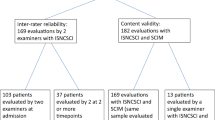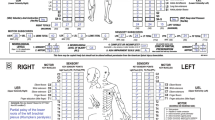Abstract
Study design
Psychometric study.
Objectives
To introduce a novel, simple, tele-assessment tool designed to report the level and severity of spinal cord injury (SCI) and to assess its reliability and validity.
Setting
Two academic-affiliated rehabilitation facilities in Thailand.
Methods
The Tele-Neurological Assessment for the level, severity, and completeness of Spinal Cord Injury (TNASCI) was designed to assess the SCI level and severity according to the International Standards for Neurological Classification of Spinal Cord Injury (ISNCSCI) using telecommunication. This study comprised three phases: (1) the development process involving three experts using the Delphi method, (2) a face validity examination of each TNASCI item’s comprehension and suitability, and (3) an evaluation of the concurrent validity, intra-rater reliability, and inter-rater reliability using data from 40 participants with chronic SCI (>12 months post-injury).
Results
The Thai version of TNASCI, was developed to contain four sections, including sensory, motor, anorectal function, and summary sections to determine the SCI level and severity grade. The assessment tool exhibited good face validity. When compared with the ISNCSCI, the TNASCI showed good to excellent inter-rater and intra-rater reliability, with an intraclass correlation coefficient (ICC) (2,1) of 0.791–0.941 and an ICC (3,1) of 0.785–1.00, and good to excellent validity in almost all sections except for the sensory-related components (r = 0.764–0.986).
Conclusions
Our TNASCI tool, which was assessed by trained clinicians, demonstrated acceptable inter-rater and intra-rater reliability, face validity, and concurrent validity. It serves as an alternative tool to evaluate the SCI level and severity predominantly in people with chronic, motor-complete SCI who cannot be evaluated using the hands-on ISNCSCI in person. However, this study is an initial step in validating a novel tele-assessment tool, with future studies needed to confirm its utility in other conditions and settings.
This is a preview of subscription content, access via your institution
Access options
Subscribe to this journal
Receive 12 print issues and online access
$259.00 per year
only $21.58 per issue
Buy this article
- Purchase on SpringerLink
- Instant access to full article PDF
Prices may be subject to local taxes which are calculated during checkout
Similar content being viewed by others
Data availability
The data that support the findings of this study are available on request from the corresponding author (PW). The data are not publicly available because of ethical restrictions.
References
Kirshblum SC, Burns SP, Biering-Sorensen F, Donovan W, Graves DE, Jha A, et al. International standards for neurological classification of spinal cord injury (revised 2011). J Spinal Cord Med. 2011;34:535–46.
Rupp R, Biering-Sørensen F, Burns SP, Graves DE, Guest J, Jones L, et al. International standards for neurological classification of spinal cord injury: revised 2019. Top Spinal Cord Inj Rehabil. 2021;27:1–22.
Franz S, Heutehaus L, Weinand S, Weidner N, Rupp R, Schuld C. Theoretical and practical training improves knowledge of the examination guidelines of the international standards for neurological classification of spinal cord injury. Spinal Cord. 2022;60:1–10.
Krisa L, Mulcahey M, Gaughan J, Smith B, Vogel L. Using a limited number of dermatomes as a predictor of the 56-dermatome test of the international standards for neurological classification of spinal cord injury in the pediatric population. Top Spinal Cord Inj Rehabil. 2013;19:114–20.
Snoswell CL, Chelberg G, De Guzman KR, Haydon HH, Thomas EE, Caffery LJ, et al. The clinical effectiveness of telehealth: a systematic review of meta-analyses from 2010 to 2019. J Telemed Telecare. 2023;29:669–84.
Wright AJ, Raiford SE Essentials of psychological tele-assessment. John Wiley & Sons; 2020.
Krach SK, Paskiewicz TL, Monk MM. Testing our children when the world shuts down: analyzing recommendations for adapted tele-assessment during COVID-19. J Psychoeduc Assess. 2020;38:923–41.
Mirbaha S, Morgan A, Tang A, Smith-Turchyn J, Richardson J. Models of telehealth service delivery in adults with spinal cord injuries: scoping review. JMIR Rehabil Assist Technol. 2023;10:e41186.
Chun A, Delgado AD, Tsai C-Y, Spielman L, Taylor K, Ramirez A, et al. An interview based approach to the anorectal portion of the international standards of neurological classification of spinal cord injury exam (IA-ISNCSCI): a pilot study. Spinal Cord. 2020;58:553–9.
DiPiro ND, Li C, Krause JS. A longitudinal study of self-reported spasticity among individuals with chronic spinal cord injury. Spinal Cord. 2018;56:218–25.
Field-Fote EC, Furbish CL, Tripp NE, Zanca JM, Dyson-Hudson T, Kirshblum S, et al. Characterizing the experience of spasticity after spinal cord injury: a national survey project of the spinal cord injury model systems centers. Arch Phys Med Rehabil. 2022;103:764–72.e2
Sweatman WM, Heinemann AW, Furbish CL, Field-Fote EC. Modified PRISM and SCI-SET spasticity measures for persons with traumatic spinal cord injury: results of a rasch analyses. Arch Phys Med Rehabil. 2020;101:1570–9.
Divanoglou A, Augutis M, Sveinsson T, Hultling C, Levi R. Self-reported health problems and prioritized goals in community-dwelling individuals with spinal cord injury in Sweden. J Rehabil Med. 2018;50:872–8.
Furbish CL, Anderson RK, Field-Fote EC. Accuracy of self-reported severity and level of spinal cord injury. Spinal Cord. 2022;60:934–41.
Okoli C, Pawlowski SD. The Delphi method as a research tool: an example, design considerations and applications. Inf Manag. 2004;42:15–29.
Hsu C-C, Sandford BA. The Delphi technique: making sense of consensus. Pract Assess Res Eval. 2007;12:10.
Keeney S, Hasson F, McKenna HP. A critical review of the Delphi technique as a research methodology for nursing. Int J Nurs Stud. 2001;38:195–200.
Devaney L, Henchion M. Who is a Delphi ‘expert’? Reflections on a bioeconomy expert selection procedure from Ireland. Futures. 2018;99:45–55.
Burns SP, Tansey KE. The expedited international standards for neurological classification of spinal cord injury (E-ISNCSCI). Spinal Cord. 2020;58:633–4.
Turner RC, Carlson L. Indexes of item-objective congruence for multidimensional items. Int J Test. 2003;3:163–71.
Koo TK, Li MY. A guideline of selecting and reporting intraclass correlation coefficients for reliability research. J Chiropr Med. 2016;15:155–63.
Portney LG, Watkins MP. Foundations of clinical research: applications to practice. Upper Saddle River, NJ: Pearson/Prentice Hall; 2009.
Itzkovich M, Gelernter I, Biering-Sorensen F, Weeks C, Laramee M, Craven B, et al. The spinal cord independence measure (SCIM) version III: reliability and validity in a multi-center international study. Disabil Rehabil. 2007;29:1926–33.
Itzkovich M, Shefler H, Front L, Gur-Pollack R, Elkayam K, Bluvshtein V, et al. SCIM III (spinal cord independence measure version III): reliability of assessment by interview and comparison with assessment by observation. Spinal Cord. 2018;56:46–51.
Klingner J, Tversky B, Hanrahan P. Effects of visual and verbal presentation on cognitive load in vigilance, memory, and arithmetic tasks. Psychophysiology. 2011;48:323–32.
Bloor M, Sampson H, Baker S, Dahlgren K. Useful but no oracle: reflections on the use of a Delphi group in a multi-methods policy research study. Qual Res. 2015;15:57–70.
Jorm AF. Using the Delphi expert consensus method in mental health research. Aust N Z J Psychiatry. 2015;49:887–97.
Acknowledgements
The authors wish to thank all staff members at the Department of Rehabilitation Medicine, Chiang Mai University for their support and assistance in the data collection. We would like to express our sincere gratitude to Chayaporn Chotiyarnwong, MD, Siam Tongprasert, MD and Pratchayapon Kammuang-lue, MD, for their comments and suggestions during the tool development process. We thank Lisa Kreiner, PhD, from Edanz (www.edanz.com/ac) for editing the English text of a draft of this manuscript.
Funding
This research project was supported by Chulabhorn Royal Academy (Project code RI-02-2565/006).
Author information
Authors and Affiliations
Contributions
The authors have contributed in the following ways: PT was responsible for the Conceptualization, Methodology, Investigation, Data Curation, Writing - Review & Editing. AE contributed to the Conceptualization, Methodology, Investigation, Data Curation, Supervision, Writing - Review & Editing. SP contributed to the Concept/Research Design, Investigation, Resources, Supervision, Writing - Review & Editing. PW was responsible for the Conceptualization, Methodology, Formal Analysis, Data Curation, Project Administration, Funding Acquisition, Writing - Original Draft, Review & Editing. All authors read and approved the final manuscript.
Corresponding author
Ethics declarations
Ethical approval
The study was approved by the Human Research Ethics Committee of Chulabhorn Research Institute (No. 129/2564) and Research Ethics Committee Panel 5, Faculty of Medicine, Chiang Mai University, Thailand (No. 391/2022) based on the Declaration of Helsinki. Written and verbal explanations of the contents of this study were provided to the participants and informed consent was obtained. We declare that all applicable institutional and governmental regulations regarding the ethical use of human volunteers were followed during the course of this research.
Competing interests
The authors declare no competing interests.
Additional information
Publisher’s note Springer Nature remains neutral with regard to jurisdictional claims in published maps and institutional affiliations.
Supplementary information
Rights and permissions
Springer Nature or its licensor (e.g. a society or other partner) holds exclusive rights to this article under a publishing agreement with the author(s) or other rightsholder(s); author self-archiving of the accepted manuscript version of this article is solely governed by the terms of such publishing agreement and applicable law.
About this article
Cite this article
Techaworarak, P., Eitivipart, A.C., Pattanakuhar, S. et al. Development of the tele-neurological assessment for the level, severity, and completeness of spinal cord injury (TNASCI): reliability and validity. Spinal Cord 63, 499–507 (2025). https://doi.org/10.1038/s41393-025-01109-6
Received:
Revised:
Accepted:
Published:
Issue date:
DOI: https://doi.org/10.1038/s41393-025-01109-6



